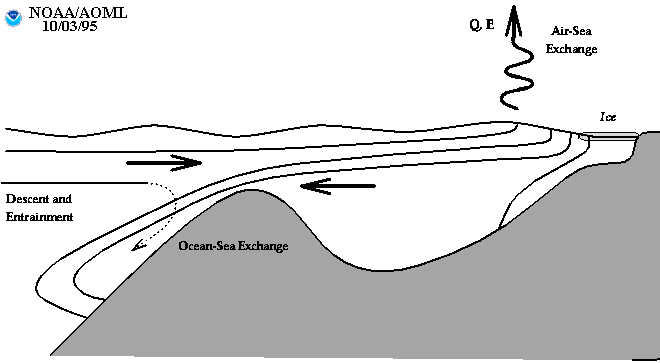 In the present
climate the densest water is produced in high latitude
marginal seas and
the deep ocean is filled with cold, polar and subpolar
waters. There
are two
important northern hemisphere outflows from the
Norwegian-Greenland Sea --
one through Denmark Strait and another
through the Faeroe Bank Channel -- and
there is at least one important southern
hemisphere outflow from the Filchner
Ice Shelf into the Weddell Sea and subsequently
into the Southern Ocean.
These northern and southern sources produce
deep waters with nearly similar
densities, however they do have different
chemical characteristics
and leave a distinctive
imprint in deep sea sediments.
Changes in chemical distributions over the deep North Atlantic
at around
ten to twenty thousand years ago indicate that the northern
hemisphere
source must have been weakened during periods of glacial
maximum. Still
further in the past, at around fifty million years ago, the deep
water in
the North Atlantic was much warmer and saltier than it is today
and must
have been produced mainly by evaporation over a subtropical
marginal sea,
perhaps something like the Mediterranean
(Figure
1).
With today's climate and continental configuration, the
Mediterranean Sea produces a warm, salty source water that is very dense,
and yet the end result of the Mediterranean outflow is an intermediate
water mass. We believe that one step toward an improved understanding of
past deep sea climates and toward forecasting future climates is to learn
what processes set the properties of marginal sea outflows, and thereby
the climate of the deep sea.
In the present
climate the densest water is produced in high latitude
marginal seas and
the deep ocean is filled with cold, polar and subpolar
waters. There
are two
important northern hemisphere outflows from the
Norwegian-Greenland Sea --
one through Denmark Strait and another
through the Faeroe Bank Channel -- and
there is at least one important southern
hemisphere outflow from the Filchner
Ice Shelf into the Weddell Sea and subsequently
into the Southern Ocean.
These northern and southern sources produce
deep waters with nearly similar
densities, however they do have different
chemical characteristics
and leave a distinctive
imprint in deep sea sediments.
Changes in chemical distributions over the deep North Atlantic
at around
ten to twenty thousand years ago indicate that the northern
hemisphere
source must have been weakened during periods of glacial
maximum. Still
further in the past, at around fifty million years ago, the deep
water in
the North Atlantic was much warmer and saltier than it is today
and must
have been produced mainly by evaporation over a subtropical
marginal sea,
perhaps something like the Mediterranean
(Figure
1).
With today's climate and continental configuration, the
Mediterranean Sea produces a warm, salty source water that is very dense,
and yet the end result of the Mediterranean outflow is an intermediate
water mass. We believe that one step toward an improved understanding of
past deep sea climates and toward forecasting future climates is to learn
what processes set the properties of marginal sea outflows, and thereby
the climate of the deep sea.
Hydrographic and XCP data taken during the Gulf of Cadiz Expedition in September 1988 were analyzed to infer the dynamics of the Mediterranean outflow from the Strait of Gibraltar and results detailed in two manuscripts (Baringer and Price, 1995a,b). These data show that the outflow transport doubles from 0.85~Sv to 1.9~Sv within the Gulf of Cadiz, and that the velocity weighted salinity decreases from 37.8 to 36.7 in the first 60~km of the path (Baringer and Price, 1995a). Gradient Richardson numbers less than 1/4 are found in the interface (up to 50~m thick) between westward flowing Mediterranean water and eastward flowing North Atlantic water, even though there is a strong stabilizing stratification present. The mixing was localized along the path of the outflow and correlated with bulk Froude numbers.
Baringer and Price (1995b) use a form of the Bernoulli function is evaluated to infer the total stress (entrainment stress and bottom drag) acting on the outflow. For the Mediterranean outflow, the total stress is as large as 5~Pa within 20~km of the strait, while further downstream the total stress decreases to about $\frac{1}{2}$~Pa. The entrainment stress estimated independently from property fluxes reaches a maximum of about 0.8~Pa at about 15~km downstream of the last sill in the Strait of Gibraltar. They find that in order to model outflows, large frictional and entrainment stresses must be anticipated and modelled through realtistic parameterizations.
Baringer, M. O'Neil and Price, J. F., 1997 Mixing and spreading of the Mediterranean outflow, Journal of Physical Oceanography, 27 (8), 1654-1677.
Baringer, M. O'Neil and Price, J. F., 1997 Momentum and energy balance of the Mediterranean outflow, Journal of Physical Oceanography, 27 (8), 1678-1692.
Baringer, M. O'Neil and Price, J. F., 1997 A review of the Physical Oceanography of the Mediterranean Outflow, Marine Geology, in press.
Baringer, M. O'Neil and Price, J. F., 1995 Mixing in the Mediterranean Outflow: Observations from the 1988 Gulf of Cadiz Expedition Deep-Sea Research, to be submitted.
Baringer, M. O'Neil and Price, J. F., 1995 Momentum and energy balance of the Mediterranean Outflow: Observations from the 1988 Gulf of Cadiz Expedition. Deep-Sea Research, to be submitted.
Baringer, M. O. and J. F. Price, 1990. A simple model of the descending Mediterranean outflow plume. Physical Oceanography of Sea Straits, Kluwer Academic Publishers, L. J. Pratt, ed., NATO-ASI series, 298--308.
Johnson, G. C. and T. B. Sanford and M. O'Neil Baringer, 1994. Stress on the Mediterranean Outflow Plume: Part I. Velocity and Water Property Measurements. JPO, 24, 2072-2083.
Price, J. F. and M. O. Baringer, 1994. Overflows and deep water production by marginal seas. Progress in Oceanography, 33, 161-200.
Price, J. F., M. O. Baringer, R. G. Lueck, G. C. Johnson, I. Ambar, G. Parrilla, A. Cantos, M. A. Kennelly and T. B. Sanford, 1993. Mediterranean outflow mixing and dynamics. Science, 259, 1277-1282.